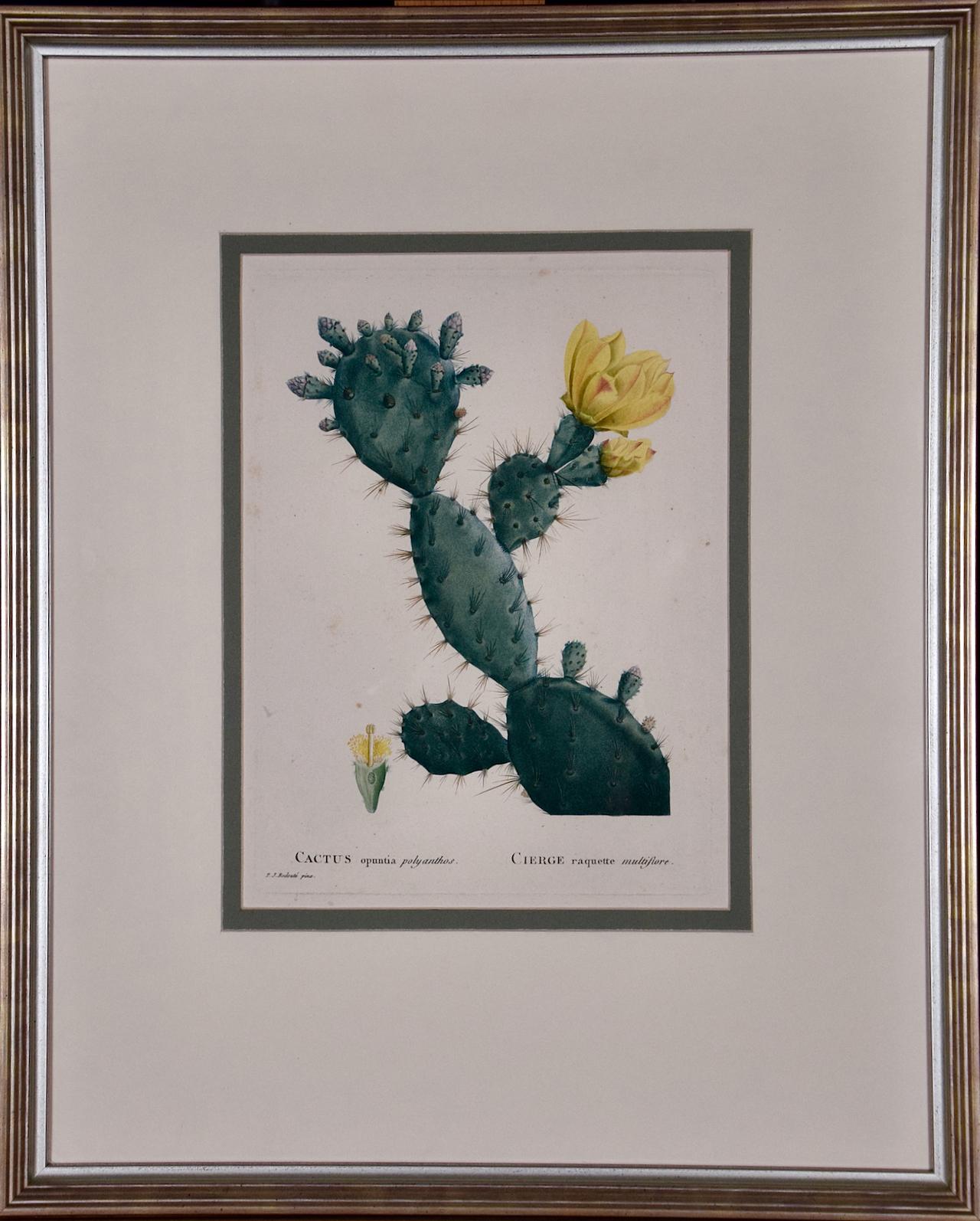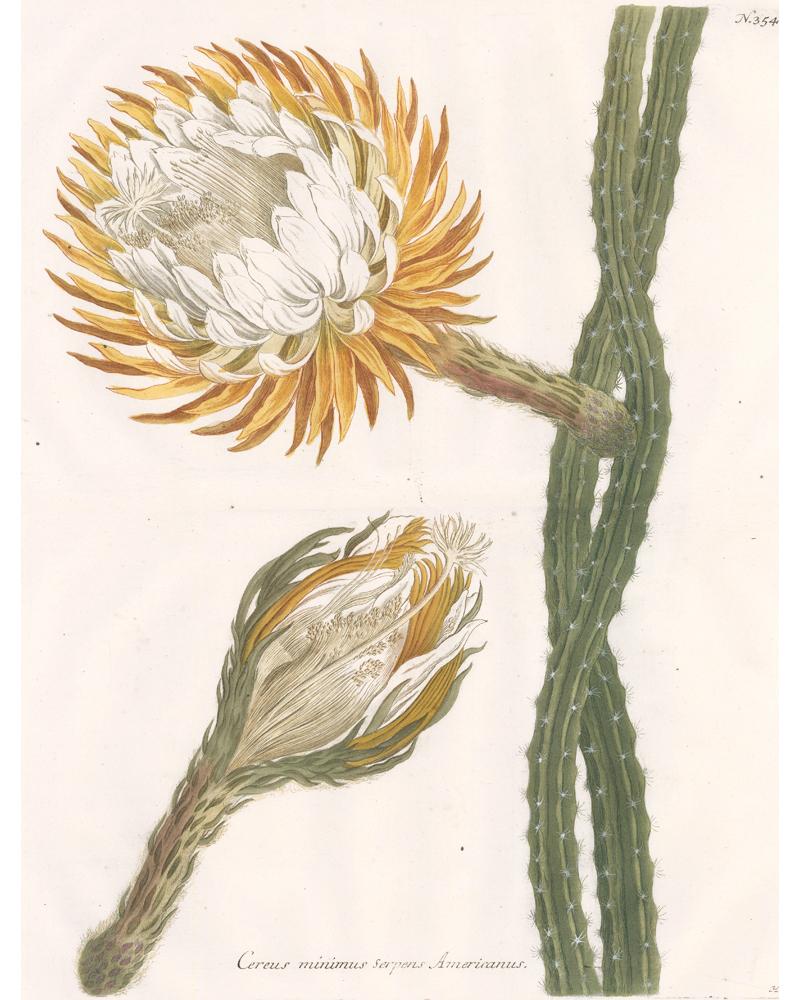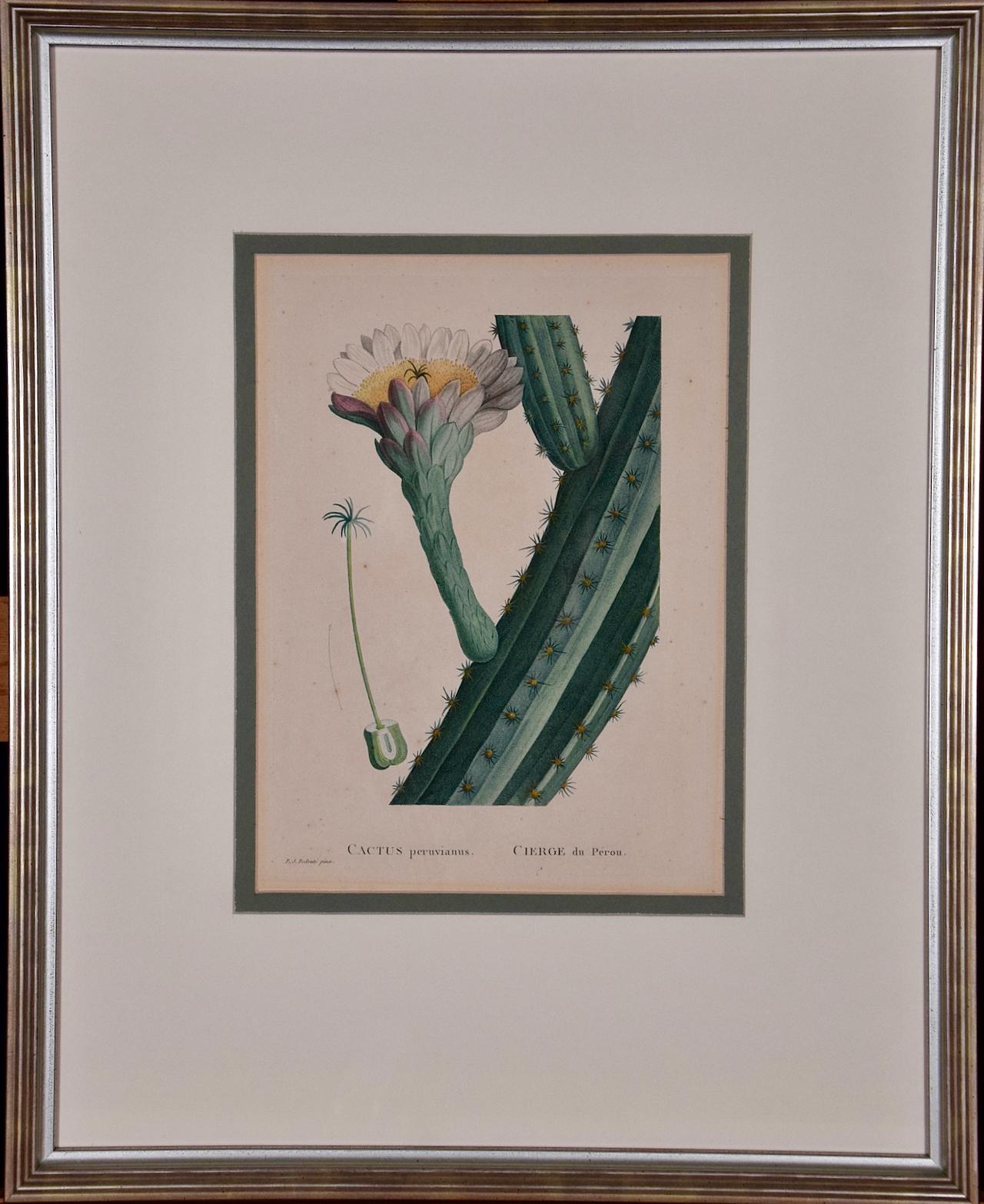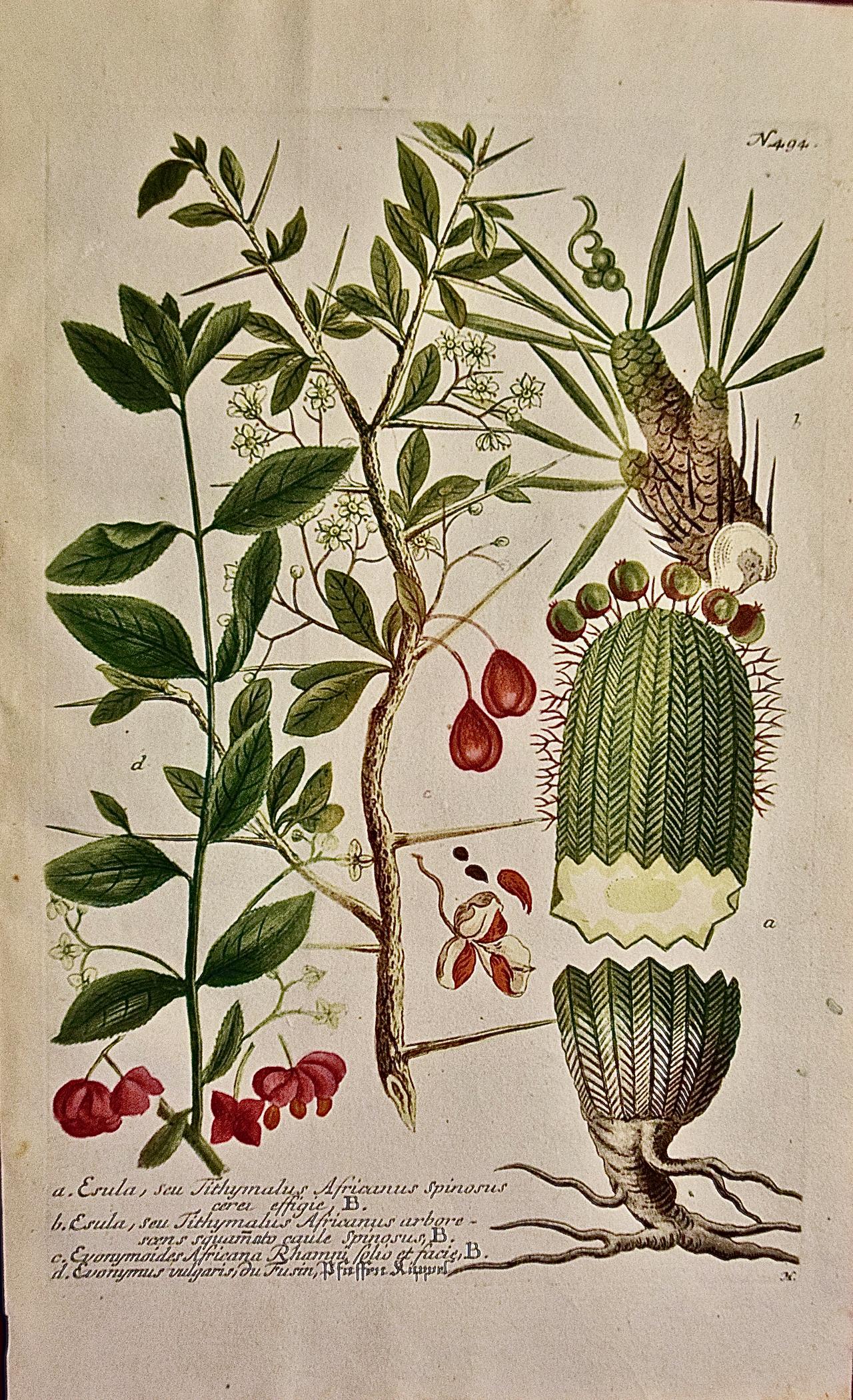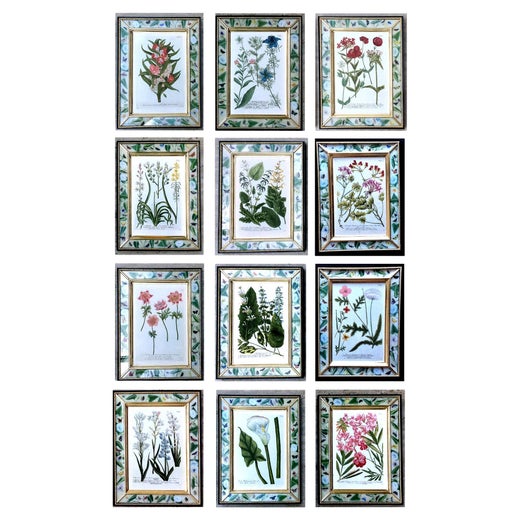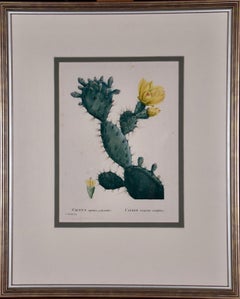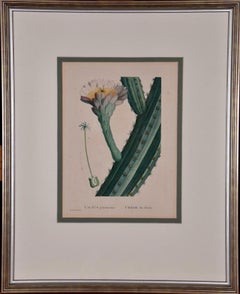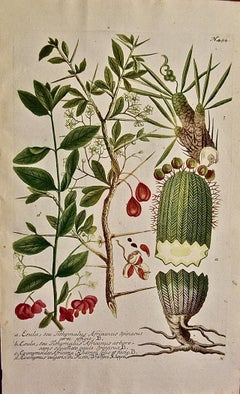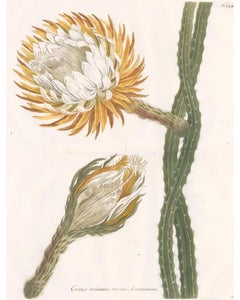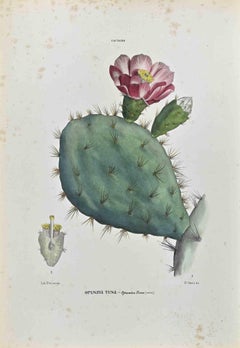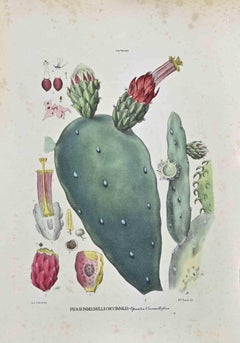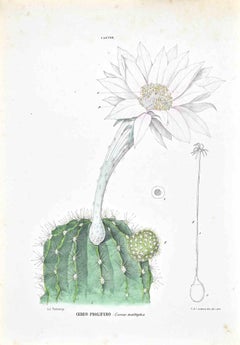Items Similar to A Flowering Cactus Plant: 18th C. Hand-colored Botanical Engraving by Weinmann
Want more images or videos?
Request additional images or videos from the seller
1 of 9
Johann Wilhelm WeinmannA Flowering Cactus Plant: 18th C. Hand-colored Botanical Engraving by Weinmann1736
1736
$775
£587.21
€673.78
CA$1,090.55
A$1,198.81
CHF 630.04
MX$14,557.98
NOK 7,859.62
SEK 7,446.43
DKK 5,028.56
About the Item
This hand-colored botanical mezzotint and line engraving by Johann Wilhelm Weinmann (1683-1741) is entitled "Cereus Erectus Altissimo Surinamensis (Cereus Cactus Plant)". It is plate 355 in Weinmann's monumental publication "Phytanthoza Iconographia", published in Amsterdam 1736-1748. The engraving depicts the flowering Cereus cactus plant.
This engraving is printed on laid chain-linked watermarked paper measuring 15.88" x 10". There are some faint barely visible spots and a small focus of paint on the left, residual from the time of the hand-coloring. There is subtle wrinkling in the upper margin on the right. There is irregularity of the left edge of the paper, where the print had been bound in the 18th century publication. The print is otherwise in very good condition.
Johann Weinmann, was a botanist and pharmacist who directed a famous pharmacy in Regensburg, Germany. The Phytanthoza Iconographia was his masterpiece, which was a huge work in eight folio volumes, which provided one of the most comprehensive botanical references of the eighteenth century. It has been described as a "pioneering work of botanical prints” and it remains today one of the most ambitious works ever undertaken, displaying over 4,000 species.
The artist for the much of the work was the gifted and very collectible Georg Dionysius Ehret (1708-1770). Born of a humble family in Heidelberg, Ehret was taught to draw by his father at an early age. As a young man, he worked as a gardener first for the Elector of Heidelburg and then the Margrave of Badaen-Durlac. He became a well respected botanist and entomologist and one of the most influential European botanical artists of all time.
- Creator:Johann Wilhelm Weinmann (1683 - 1741, German)
- Creation Year:1736
- Dimensions:Height: 15.88 in (40.34 cm)Width: 10 in (25.4 cm)
- Medium:
- Movement & Style:
- Period:
- Framing:Framing Options Available
- Condition:
- Gallery Location:Alamo, CA
- Reference Number:Seller: # 33721stDibs: LU1173215504132
Johann Wilhelm Weinmann
Johann Wilhelm Weinmann (1683-1741) was a botanist, pharmacist and academic scholar who directed a famous pharmacy in Regensburg. The "Phytanthoza Iconographia" was his masterpiece; a huge work in eight folio volumes, which provided one of the most comprehensive botanical references of the eighteenth century. It has been described as a "pioneering work of botanical prints” and it remains today one of the most ambitious works ever undertaken, displaying over 4,000 species. The artist for much of the work was the gifted and very collectible Georg Dionysius Ehret (1708-1770). Born into a humble family in Heidelberg, Germany, Ehret was taught to draw by his father at an early age. As a young man, he worked as a gardener, first for the Elector of Heidelberg and then the Margrave of Badaen-Durlac. He became a well respected botanist and entomologist and one of the most influential European botanical artists of all time.
About the Seller
5.0
Gold Seller
Premium sellers maintaining a 4.3+ rating and 24-hour response times
Established in 2011
1stDibs seller since 2019
291 sales on 1stDibs
Typical response time: 1 hour
- ShippingRetrieving quote...Shipping from: Alamo, CA
- Return Policy
Authenticity Guarantee
In the unlikely event there’s an issue with an item’s authenticity, contact us within 1 year for a full refund. DetailsMoney-Back Guarantee
If your item is not as described, is damaged in transit, or does not arrive, contact us within 7 days for a full refund. Details24-Hour Cancellation
You have a 24-hour grace period in which to reconsider your purchase, with no questions asked.Vetted Professional Sellers
Our world-class sellers must adhere to strict standards for service and quality, maintaining the integrity of our listings.Price-Match Guarantee
If you find that a seller listed the same item for a lower price elsewhere, we’ll match it.Trusted Global Delivery
Our best-in-class carrier network provides specialized shipping options worldwide, including custom delivery.More From This Seller
View AllFlowering Prickly Pear Cactus: Framed 18th C. Hand-colored Engraving by Redoute
By Pierre-Joseph Redouté
Located in Alamo, CA
This is a hand-colored stipple engraving entitled "Cactus Opuntia Polyanthos, Cierge Raquette Multiflore" (Prickly Pear Cactus) by Pierre-Joseph Redouté, Plate 59 from his illustrated publication 'Plantarum Historia Succulentarum ou Histoire des Plantes Grasses', published in Paris in 1799. Redoute was a pioneer of the stipple engraving technique, which he used to create this image. It involves utilizing a series of small dots worked into a copper plate rather than the more common lines. These dots can be made smaller or thicker depending on the degree of opacity the artist intends for various areas of the print. When inked and applied to paper, this allows for a greater portion of the paper to be seen, which accentuates the appearance of luminosity of the subject the artist is creating. Different color inks are used in the printing process, a time consuming technique known as "a la poupee". The engraving is then finished with watercolor to further enhance the beauty and realism of the print subject.
This engraving of a flowering cactus is presented in a double mat; white outer mat and heather green inner mat.The mat measures 20" x 16" and the sheet measures 19.5" x 13.38". There are wide margins with a few short tears and chips along the the right and upper edges, which are all covered by the mat. There are small spots predominantly in the margins, but a few are present in the image area, but the print is otherwise in very good condition. There is another Redoute flowering cactus listed on 1stdibs, LU117326854582. The pair would make an attractive display grouping.
Pierre-Joseph Redouté (1759-1840), was a painter and botanist originally from Belgium, who pursued his extremely successful artistic career in France. He is well known for his watercolor paintings of roses, lilies and other flowers and their subsequent folio-sized, color stipple engravings. Some believe him to be the greatest botanical illustrator of all time. Redouté was a favorite of the French royal court at the time and of the post French...
Category
Late 18th Century Naturalistic Still-life Prints
Materials
Engraving
Flowering Cactus: A Framed 18th C. Hand-colored Engraving by Redoute
By Pierre-Joseph Redouté
Located in Alamo, CA
This framed hand-colored stipple engraving entitled "Cactus Peruvianus Cierge du Pérou" by Pierre-Joseph Redouté, Plate 58 from his illustrated publication 'Plantarum Historia Succulentarum ou Histoire des Plantes Grasses', published in Paris in 1799. It depicts a branching limb of a cactus with a beautiful flower. There is a separate detail of the anatomy of a seed with early growth. Redoute was a pioneer of the stipple engraving technique, which he used to create this image. It involves utilizing a series of small dots worked into a copper plate rather than the more common lines. These dots can be made smaller or thicker depending on the degree of opacity the artist intends for various areas of the print. When inked and applied to paper, this allows for a greater portion of the paper to be seen, which accentuates the appearance of luminosity of the subject the artist is creating. Different color inks are used in the printing process, a time consuming technique known as "a la poupee". The engraving is then finished with watercolor to further enhance the beauty and realism of the print subject.
This engraving of a flowering cactus is presented in silver-colored ribbed wood frame and a double mat; cream-colored outer mat and heather green inner mat. The frame measures 21.25" high by 17.25" wide by 1.13" deep. The sheet measures 19.88" high by 14" wide. There are wide margins with a few short tears and chips along the the left, right and upper edges, which are all covered by the mat. There are small spots predominantly in the margins, with a few present in the image area. The print is otherwise in very good condition. There is another Redoute flowering cactus listed on 1stdibs, LU117326853392, which is framed and matted identically to this one. The pair would make an attractive display grouping.
Pierre-Joseph Redouté (1759-1840), was a painter and botanist originally from Belgium, who pursued his extremely successful artistic career in France. He is well known for his watercolor paintings of roses, lilies and other flowers and their subsequent folio-sized, color stipple engravings. Some believe him to be the greatest botanical illustrator of all time. Redouté was a favorite of the French royal court at the time and of the post French...
Category
Late 18th Century Naturalistic Still-life Prints
Materials
Engraving
Cactus & Rose of Jericho Plants: A Besler Hand-colored Botanical Engraving
Located in Alamo, CA
A hand-colored copper plate engraving depicting flowering "Melocactos" (Turk's Cap Cactus or Mother-in-law's Cushion), "Rosa Hiericontea aperta" (Rose of Jericho Unfolded), "Rosa Hie...
Category
Early 18th Century Academic Still-life Prints
Materials
Engraving
Flowering Spurge: 18th Century Hand-colored Botanical Engraving by J. Weinmann
By Johann Wilhelm Weinmann
Located in Alamo, CA
This hand-colored botanical mezzotint and line engraving by Johann Wilhelm Weinmann (1683-1741) is entitled "A. Esula seu Tithyinalus Africanus SpinosusCera Effigie, B. Esula seu Ti...
Category
Mid-18th Century Naturalistic Still-life Prints
Materials
Engraving, Mezzotint
Flowering Cotton Plant: 18th Century Hand-colored Weinmann Botanical Engraving
By Johann Wilhelm Weinmann
Located in Alamo, CA
This striking hand-colored botanical mezzotint and line engraving is entitled "Gnaphalium, Gossypium (Cotton Plant)". It is plate 551 in Johann Weinmann's monumental publication "Phy...
Category
Mid-18th Century Naturalistic Still-life Prints
Materials
Engraving, Mezzotint
Flowering Trumpet Plant: 18th C. Hand-colored Botanical Engraving by Weinmann
By Johann Wilhelm Weinmann
Located in Alamo, CA
This hand-colored botanical mezzotint and line engraving by Johann Wilhelm Weinmann (1683-1741) is entitled "Stramonia Aegyptiaca foetida semine pallido flore albo duplici triplicive...
Category
Mid-18th Century Naturalistic Still-life Prints
Materials
Engraving, Mezzotint
You May Also Like
Flowering Cactus Engraving
By Johann Wilhelm Weinmann
Located in New York, NY
Original engraving by Johann Wilhelm Weinmann from "Phytanthosa Iconographia." Ratisbon, 1737-1745.
This plate: Cereus Minimus Serpens Americanus. [Cactus].
Mezzotint engraving print...
Category
Early 18th Century Prints and Multiples
Materials
Laid Paper
The Cactaceae - Lithograph by Vincenzo Tenore - 1870s
Located in Roma, IT
Lithograph hand watercolored.
Plate from "Atlante di Botanica popolare ossia Illustrazione di Piante Notevoli di ogni famiglia" (Atlas of popular botany or illustration of notable p...
Category
1870s Modern Figurative Prints
Materials
Lithograph
The Cactaceae - Lithograph by Vincenzo Tenore - 1870s
Located in Roma, IT
Lithograph hand watercolored.
Plate from "Atlante di Botanica popolare ossia Illustrazione di Piante Notevoli di ogni famiglia" (Atlas of popular botany or illustration of notable p...
Category
1870s Modern Figurative Prints
Materials
Lithograph
The Cacti - Lithograph by Vincenzo Tenore - 1870s
Located in Roma, IT
Lithograph hand watercolored.
Plate from "Atlante di Botanica popolare ossia Illustrazione di Piante Notevoli di ogni famiglia" (Atlas of popular botany or illustration of notable ...
Category
19th Century Modern Figurative Prints
Materials
Lithograph
Pair of Original Antique Botanical Prints- Cactus. Dated 1826
Located in St Annes, Lancashire
Wonderful pair of cactus prints.
Lithographs
Original hand color
Published by S.Curtis. Dated 1826
Unframed.
Category
Antique 1820s English Georgian Prints
Materials
Paper
Acer & Carduus - 18th century Weinmann botanical plant flower engraving
By Johann Wilhelm Weinmann
Located in Melbourne, Victoria
'Acarna Theophrasti' and 'Acer Campestre minus'
Mezzotint printed in colours. Circa 1740.
From Johann W Weinmann's Phytanthoza Iconographia, published in Regensburg 1737-45. The fi...
Category
18th Century Naturalistic Still-life Prints
Materials
Engraving
More Ways To Browse
18th Century Colored Engraving
Hand Colored Botanical
18th Century Botanicals
Hand Colored Botanical Prints
18th Century Botanical Prints
Elizabeth Osborne Poster
Gary Bukovnik Posters
Geraldine Girvan
Hugh Kepets On Sale
Japanese Botanical Prints
Lichtenstein Spray Can
Michelle Stuart On Sale
Mr Brainwash Flower
Oisin Byrne
Paris Review Posters
Paul De Longpre Vintage Prints
Robert Furber Twelve Months Of Flowers
Robert Furber
